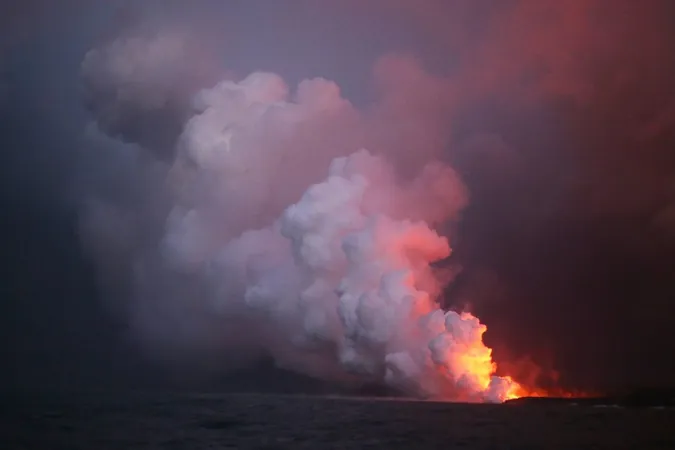
Hawaiian Volcano's Eruption Fuels Unprecedented Ocean Life Explosion 1,200 Miles Away!
2025-04-10
Author: Jia
A Volcanic Force of Nature
In 2018, the Kīlauea volcano in Hawai'i unleashed a colossal plume of ash that soared nearly five miles into the atmosphere, setting off a chain reaction across the North Pacific Ocean.
From Ash to Ocean: The Blooming Miracle
Recent findings from an international team of researchers published in JGR Oceans reveal that this volcanic ash became the catalyst for one of the largest phytoplankton blooms ever recorded, a staggering event occurring over 1,200 miles from the eruption site.
Professor David Karl from the University of Hawai'i at Mānoa remarked, "The scale and duration of this bloom were both massive, establishing it as likely the largest observed in the North Pacific. This occurrence highlights the complex interplay between terrestrial eruptions and marine ecosystems far from shore."
The Unsung Heroes of the Ocean
Phytoplankton are tiny, plant-like organisms that form the foundation of the marine food web and play a crucial role in our planet’s carbon cycle. While Kīlauea is undeniably one of the most active volcanoes globally, this eruption marks the first documented instance where its ash has been linked to such an extraordinary bloom at such an offshore distance.
A Volcanic Eruption Like No Other
The 2018 eruption was Kīlauea's most significant in over two centuries, spewing rivers of lava into the ocean and releasing immense quantities of gases—around 50 kilotons of sulfur dioxide and 77 kilotons of carbon dioxide daily at its peak.
Previous studies have shown that when hot lava meets ocean water, it stirs nutrient-rich elements from the depths to the surface, creating a perfect environment for phytoplankton to thrive. However, in this case, the ash carried by the winds broadened the reach even further, leading to an extraordinary phytoplankton explosion.
Tracking the Ash: A Scientific Journey
After the eruption, ash particles were blown westward by powerful winds. Co-author Dr. Wee Cheah from Universiti Malaya explained that researchers used satellite data to trace the ash’s route and measured how much settled into the sea. Notably, they analyzed changes in ocean color—an indicator of phytoplankton—from space.
What they discovered was remarkable: a vast bloom in an area notorious for rarely experiencing such growth. The ash carried essential nutrients, particularly iron, critical for phytoplankton growth, igniting a remarkable response.
Nature's Own Carbon Sink
The phytoplankton bloom resulted in an enormous amount of organic matter. When these organisms died, much of their biomass sank to the ocean floor, effectively sequestering carbon—a natural form of carbon capture.
"Our estimates suggest that the export of organic carbon may equate to about half of the carbon dioxide released from the eruption," Karl stated, explaining how this marine carbon dioxide sequestration mechanism likely happens whenever volcanic eruptions inject ash into the atmosphere, enriching distant waters.
Future Investigations on the Horizon
Looking to the future, researchers are keen to monitor volcanic events in real-time. Should another major eruption occur, they plan to deploy research vessels to observe how similar blooms develop, writing the next chapter in this extraordinary connection between land and sea.
Curious about the study? Discover more about how Kīlauea's volcanic ash triggered a massive phytoplankton bloom in nutrient-poor regions of the North Pacific Subtropical Gyre.
(Image: Kīlauea volcanic eruption in 2018. Credit: Getty)



 Brasil (PT)
Brasil (PT)
 Canada (EN)
Canada (EN)
 Chile (ES)
Chile (ES)
 Česko (CS)
Česko (CS)
 대한민국 (KO)
대한민국 (KO)
 España (ES)
España (ES)
 France (FR)
France (FR)
 Hong Kong (EN)
Hong Kong (EN)
 Italia (IT)
Italia (IT)
 日本 (JA)
日本 (JA)
 Magyarország (HU)
Magyarország (HU)
 Norge (NO)
Norge (NO)
 Polska (PL)
Polska (PL)
 Schweiz (DE)
Schweiz (DE)
 Singapore (EN)
Singapore (EN)
 Sverige (SV)
Sverige (SV)
 Suomi (FI)
Suomi (FI)
 Türkiye (TR)
Türkiye (TR)
 الإمارات العربية المتحدة (AR)
الإمارات العربية المتحدة (AR)